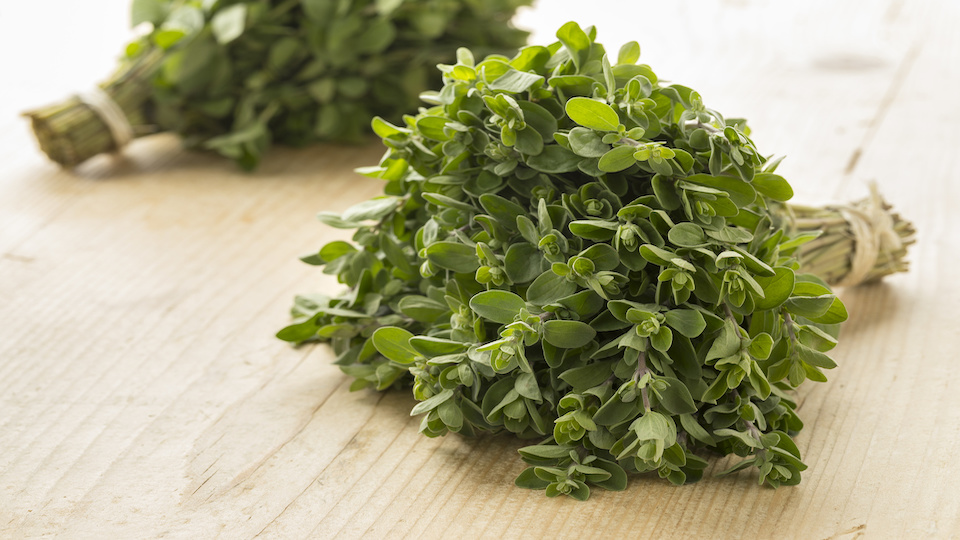Marjoram (Origanum majorana) is a milder and sweeter cousin of the popular pizza seasoning oregano, but not as well known. It’s usually referred to as ‘Sweet Marjoram, while, interestingly, oregano is called ‘Wild Marjoram’ (Origanum vulgare) in their native Mediterranean region. Both belong to the mint family.
Sweet marjoram is very similar to oregano in appearance and growth habit but has fuzzy leaves that look silvery and more rounded, compared to the greener leaves with pointed tips that oregano has. If that doesn’t help, the aroma from crushed leaves will readily distinguish them.
Marjoram is not as hardy as oregano, so it may have to be grown as an annual in many places where oregano is perennial.
Growing sweet marjoram in the garden
Marjoram is best grown from cuttings because seeds have relatively low germination rate, and the seedlings take time to grow and flourish. Get well-rooted plants or cuttings in spring and plant them in the garden after all risk of frost is past. Even light frosts can kill this tender plant before it gets a chance to take off. On the other hand, warm soil promotes vigorous growth and helps the plant spread faster.
Marjoram, with its tiny, silver-green leaves, makes a great bedding plant in mixed plantings, especially along the edges where it will not be lost among taller plants. The plant does not grow beyond 1-2 ft in height, but spreads a bit, although it does not ramble too much or become invasive as many other mint family herbs do. In places with cold winters, it completely dies out and has to be replanted every spring.
Choose a sunny spot
Marjoram does best in full sun and fertile soil. It likes to stay on the dry side, so make sure the bed has well-draining soil. Add river sand to increase drainage, if required, or plant in a raised bed. Since the herb is only used occasionally, 2-3 plants might be sufficient for a home garden.
Watering and feeding
Marjoram, with its hairy leaves, is somewhat drought tolerant, but frequent wilting may cause the plant to age too early and start flowering. A good soaking once every three days should keep it happy. Slight wilting around midday is normal, but if the plant does not recover quickly, water more frequently.
Feed once a month with a general all-purpose fertilizer through spring and summer. Organic fertilizers that enrich the soil are best.
Pruning/Harvesting
Regular trimming will provide you with enough herb to use fresh in soups and salads and even some to share. It will also promote bushy growth and keep the plant young by delaying flowering.
When the plant finally starts to flower, harvest all the stem tips and then prune it hard, removing two-thirds of the top growth. Fresh young branches will arise from what remains, and you will be able to have another harvest before winter.
Growing sweet marjoram in pots
Marjoram is suitable for growing in pots, by itself or with other herbs. However, remember that it does not like too much water, so rosemary or sage might make good companions.
Use well-draining soil mix by combining equal amounts of sand and compost. Pot grown marjoram can be overwintered by moving it indoors to a sunny south-facing window.
Propagation
Marjoram is easily propagated from stem cuttings. Young, growing stems are best for rooting. Snip off 3-4 inch long stems in summer before the plant starts to flower. Remove lower leaves and insert into moist sand or perlite and keep in a warm place. Transfer to individual pots when the cuttings have developed a good root system. This is also an easy way to make your own planting material for next spring.
Drying marjoram
Dried marjoram has a flavor that’s very similar to the fresh herb, so both can be used interchangeably in dishes that call for either of them. When you want to dry the herb for future use, the stem tips are ideally snipped just before the plant starts flowering. This is the time when it has maximum flavor, although the essential oil of marjoram is derived from flowering branches.
Use scissors to cut off 3 inches long stem tips and lay them in a single layer on a tray lined with parchment paper. Slow drying in the oven is best for preserving flavor, so keep the tray in an oven set to 150 F. The slender twigs and leaves should dry within 2-3 hours. Store in a dry and airtight bottle. Air drying in the shade for a day also works. Be sure that the twigs are completely dry and brittle before storing.
Sweet marjoram butter
Mix together 1 tablespoon of finely chopped fresh marjoram – 1 to 2 inches of tender stem tips with leaves – and 6 tablespoons softened butter. Mix in salt and pepper to taste. Shape into a roll and refrigerate. This butter goes very well with fish, clam, grilled lamb, and sausages.
Enjoy the fragrance
Crush a few leaves and sniff the sweet scent for a quick dose of aromatherapy. Fresh sprigs of sweet marjoram are a great addition to flower arrangements and dried flower buds can be used in potpourris and linen sachets.
-Susan Patterson




